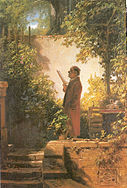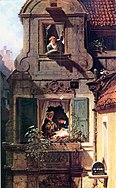art.wikisort.org - Artist
Carl Spitzweg (February 5, 1808 – September 23, 1885) was a German romanticist painter, especially of genre subjects. He is considered to be one of the most important artists of the Biedermeier era.
This article may be expanded with text translated from the corresponding article in German. (September 2020) Click [show] for important translation instructions.
|
Carl Spitzweg | |
|---|---|
 Carl Spitzweg in a photograph taken c. 1860 | |
| Born | February 5, 1808 Unterpfaffenhofen, Kingdom of Bavaria |
| Died | September 23, 1885 (aged 77) Munich, German Empire |
| Nationality | German |
| Known for | Painter, poet, artist |
| Movement | German Romanticism, Biedermeier |
Life and career
Spitzweg was born in Unterpfaffenhofen, near Munich, Bavaria, the second of three sons of Franziska (née Schmutzer) and Simon Spitzweg.[1] His father, a wealthy merchant, had Carl trained as a pharmacist. He attained his qualification from the University of Munich but, while recovering from an illness, he took up painting.
Spitzweg was self-taught as an artist, starting out by copying the works of Flemish masters. He contributed his first work to satiric magazines. Upon receiving an inheritance in 1833, he was able to dedicate himself to painting.
Later, Spitzweg visited European art centers in Prague, Venice, Paris, London, and Belgium studying the works of various artists and refining his technique and style. His later paintings and drawings are often humorous genre works. Many of his paintings depict sharply characterized eccentrics, for example The Bookworm (1850) and The Hypochondriac (c. 1865, in the Neue Pinakothek, Munich).
His paintings inspired the musical comedy Das kleine Hofkonzert by Edmund Nick.
Playing Piano, an etching by Spitzweg, was found as part of the Munich Art Hoard.[2][3]
Spitzweg is buried in the Alter Südfriedhof in Munich.[4]
Forgeries
In the late 1930s an art forgery case in Germany involved 54 paintings which had been passed off as Spitzweg originals. They had been painted by a Traunstein copyist named Toni who worked from reproductions and picture postcards. Toni signed the works with his own name as "after Spitzweg", but fraudsters later removed his name and artificially aged the paintings in order to sell them as originals. At the Stuttgart Criminal Court Assizes the conspirators were jailed for up to ten years for the swindle.[5]
Selected paintings
- The Bookworm, original 1850, Museum Georg Schäfer. Two other versions exist.
- Music-making Hermit before his Rocky Abode, c. 1856–1858
- The Eye of the Law (Justitia), 1857
- In the Harem, after 1855, Museum Georg Schäfer
- The Poor Poet, 1839, Neue Pinakothek
- Newspaper reader in his backyard, c. 1845–1858
- The butterfly hunter, 1840, a depiction from the era of butterfly collection
- The Letter Carrier in the Rose Valley, c. 1858–18
- Gnome Watching Railway Train, c. 1848
- The Attic, c. 1840s
- The Hermit Asleep
- The Painter in a Forest Clearing, Lying under an Umbrella, c. 1850
- Arrival of the Stagecoach, c. 1859
- The Serenade, 1854
- The Intercepted Love Letter, c. 1860
References
- Jensen, Jens Christian (2002). Karl Spitzweg, Museum Georg Schäfer. Prestel. p. 342.
- "Photo Gallery: Munich Nazi Art Stash Revealed". Spiegel. November 17, 2013. Retrieved November 17, 2013.
- Times, The New York (2013-11-12). "List of 25 Artworks Seized in Germany Released". The New York Times. ISSN 0362-4331. Retrieved 2022-08-09.
- "Carl Spitzweg | German painter | Britannica". www.britannica.com. Retrieved 2022-08-09.
- Schuller, Sepp. (1960) Forgers, Dealers, Experts: Adventures in the Twilight of Art Forgery. Translated from the German by James Cleugh. London: Arthur Barker, p. 93.
Sources
- Murray, P. & L. (1996). Dictionary of Art and Artists. London: Penguin Books. ISBN 0-14-051300-0.
External links
 Media related to Carl Spitzweg at Wikimedia Commons
Media related to Carl Spitzweg at Wikimedia Commons- Biography and selected paintings of Carl Spitzweg
- The Spitzweg Game Archived 2004-01-12 at the Wayback Machine
- Spitzweg Gallery at MuseumSyndicate
- Milwaukee Art Museum has a large Spitzweg collection
- German masters of the nineteenth century: paintings and drawings from the Federal Republic of Germany, a full text exhibition catalog from The Metropolitan Museum of Art, which contains material on Carl Spitzweg (no. 87–90)
На других языках
[de] Carl Spitzweg
Franz Carl Spitzweg (veraltet auch: Karl Spitzweg; * 5. Februar 1808 in München; † 23. September 1885 ebenda) war ein bedeutender[1][2] deutscher Maler und Zeichner der Spätromantik und des Biedermeiers.- [en] Carl Spitzweg
[es] Carl Spitzweg
Carl Spitzweg (Unterpfaffenhofen, 5 de febrero de 1808 - Múnich, 23 de septiembre de 1885) fue un pintor alemán del Romanticismo, considerado entre los representantes más importantes del período Biedermeier.[fr] Carl Spitzweg
Carl Spitzweg est un peintre et poète allemand né le 5 février 1808 à Unterpfaffenhofen, quartier de Germering près de Munich (Bavière) et mort le 23 septembre 1885 à Munich.[it] Carl Spitzweg
Carl (o Karl) Spitzweg (Unterpfaffenhofen, 5 febbraio 1808 – Monaco di Baviera, 23 settembre 1885) è stato un pittore tedesco di stile Biedermeier nonché una delle figure più importanti della vita culturale tedesca del XIX secolo.[ru] Шпицвег, Карл
Карл .mw-parser-output .ts-comment-commentedText{border-bottom:1px dotted;cursor:help}@media(hover:none){.mw-parser-output .ts-comment-commentedText:not(.rt-commentedText){border-bottom:0;cursor:auto}}Шпицвег (нем. Carl Spitzweg; 5 февраля 1808, Гермеринг — 23 сентября 1885, Мюнхен) — немецкий живописец, рисовальщик и иллюстратор, один из ярчайших представителей стиля бидермайер.Другой контент может иметь иную лицензию. Перед использованием материалов сайта WikiSort.org внимательно изучите правила лицензирования конкретных элементов наполнения сайта.
WikiSort.org - проект по пересортировке и дополнению контента Википедии














